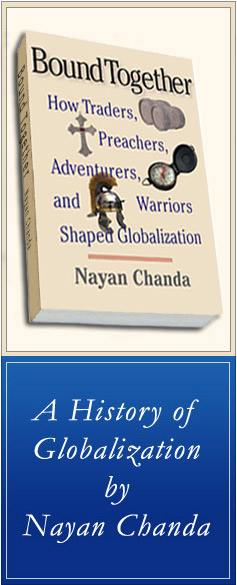The New York Sun
The Rise Of Global History
—Gaurav Tiwari
One day several years ago, a man in New Haven, Conn., swabbed
the inside of his cheek and sent off the sample in a vial marked only
with a number to a National Geographic lab. A few weeks later, he
logged onto the National Geographic Web site, punched in his number,
and learned two things. The first was specific: The man's DNA was that
of a group from Africa that represented "one of the very earliest
premigrations into India." His Y chromosome had an M168 marker,
which signaled that some of his ancestors had spent time in Ethiopia.
But the second thing that showed up was much more general: He was
the descendant of an African father.
The man with this DNA is Nayan Chanda, a scholar and widely admired journalist who for many years has not only studied international interaction but also personified globalization. Born in India, educated in Paris, Mr. Chanda reported on both the economic rise of postwar Asia and the fall of Saigon and Phnom Penh.
Now, as director of publications at Yale's Center on Globalization, he has produced "Bound Together" (Yale University Press, 320 pages, $25), a most readable history of human interconnectedness. The book reminds us of something important: Although globalization may seem to intrude unexpectedly in our lives, whether in the form of foreign capital or the SARS virus, all it really does is disclose to us who we already were. What's more, the process is not new but rather age-old and, on balance, beneficent.
"Bound Together" starts at the earliest stage in our biological history, in Africa. Mr. Chanda tracks the path of the few hundred people in Africa as they migrated across the globe and begat the 6 billion people that now inhabit our planet. Part of his story is biological. The author meticulously covers the external physical differences that evolved among peoples - not merely dark skins and light, but also additional differentiations and the reasons for them.
The skin of women in a given ethnic group, for example, tends to be between 3% and 4% lighter than that of males, probably because women need more sunlight to absorb the Vitamin D that helps them produce healthy babies. But these external differences are, Mr. Chanda emphasizes, merely that. The most astounding discovery of the geneticists is that, as a scientist tells him, "The remainder of our genetic makeup hardly differs at all."
Next Mr. Chanda turns to the most obvious globalizing force: the entrepreneurial trader. He covers Vasco da Gama's voyage to India, Christopher Columbus's discovery of the New World, and the explorations of Africa by Chinese admiral Zheng He. "Bound Together" also takes a look at the fashion in which trade gains facilitate globalization. Western steamships dropped huge rolls of wire down into the Atlantic when laying the first trans-Atlantic cable. But those wires could only function well because they were encased in gutta-percha rubber harvested in the British colony of Malaya. The new telegraphic cable, wrote the brother of one of the cable engineers, was like "a living fleshy bond between severed portions of the human family."
Mr. Chanda, who covered the depredations of Pol Pot for Reuters, does not neglect the ugly side of the globalization process. Slavery was among the first things that came to mind when Columbus set foot in the New World: He wrote to Ferdinand of Castile that "with fifty men we could subjugate them all and make them do whatever we wish." Nor were the English better. The governor of Carolina, John Archdale, wrote in the 1690s that the hand of God had been "eminently seen in thinning the Indians to make room for the English." The slave trade in the Sudan is the modern version of this very global form of economic servitude. So were the 54 stowaway Chinese who were discovered, most of them dead, at the port of Dover in June 2000.
Among the illuminating parts of this book is the chapter about preachers. We tend to think of religion and commerce separately, but, as Mr. Chanda points out, David Livingstone, Africa's most famous missionary, believed they were related. Railroads or telegraphs, Livingstone wrote, "make the world one, and capital, like water, tends to a common level." Mr. Chanda argues that some of the present day international non-governmental organizations such as Human Rights Watch have become the equivalent of preachers, similar in mission and aiming to promote the common good for all. Where Livingstone had South Africans to rescue, Human Rights Watch has Darfur.
Mr. Chanda is no partisan of pure laissez-faire globalization. He believes there is a need for coordinated intervention to reduce world poverty levels and to engage the lesser developed countries into the globalized market economy. Still, he recognizes that trade and economic growth can do the most to help all. The catch, he says, is to help the broad middle, for "trade must raise average incomes before it can also lift the real incomes of the poor."
On balance, however, this book tells a happy story, of a great community more voluntary than compulsory. Or, as Mr. Chanda puts it in describing his emotion upon receiving the National Geographic DNA report: "Suddenly the aphorism from the Upanishads I had heard growing up in India made sense: Vasudhaiva kutumbkham, "the whole world is a family."
—Mr. Tiwari is a research associate at the Council on Foreign Relations in New York.